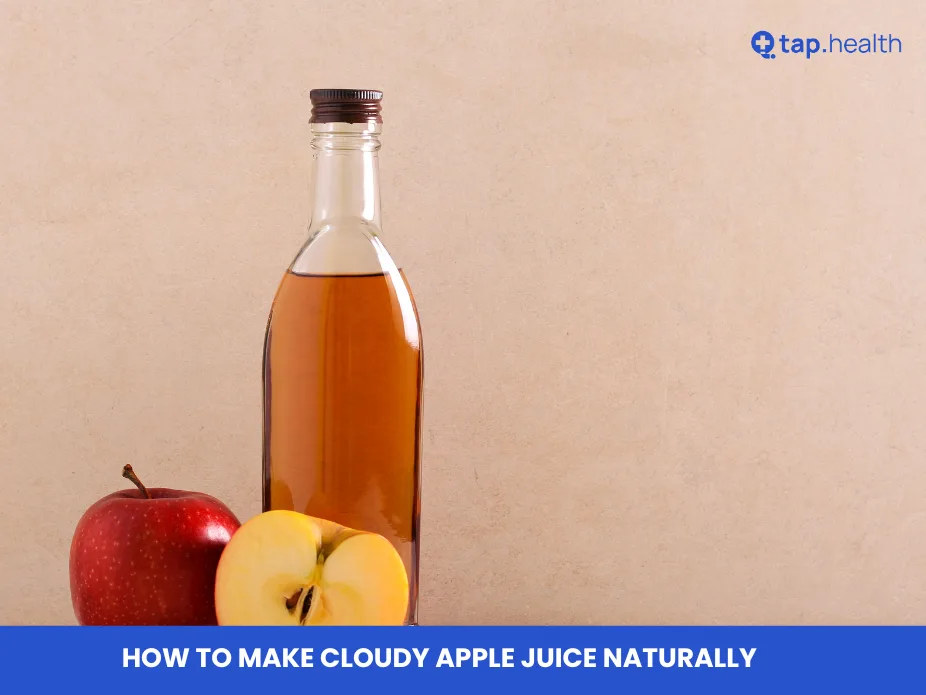Apple juice is one of the most refreshing beverages that people of all ages enjoy. It’s a great way to stay hydrated, loaded with vitamins, and full of natural sweetness. While many people opt for clear, store-bought apple juice, there’s something special about cloudy apple juice. It’s more natural, retaining more nutrients and fiber from the apples. So, if you’re wondering how to make cloudy apple juice naturally, you’re in the right place!
In this comprehensive guide, we’ll walk you through the process of making cloudy apple juice at home, the benefits of this method, and some tips for getting the most out of your juice.
What is Cloudy Apple Juice?
Cloudy apple juice is the natural, unfiltered form of apple juice that retains the pulp, fibre, and most of the nutrients found in fresh apples. Unlike clear apple juice, which is filtered and processed to remove most of the pulp, cloudy apple juice is thicker, has a deeper flavour, and offers more health benefits.
In most store-bought apple juices, the cloudy version is often pasteurised and filtered to ensure a long shelf life. However, cloudy apple juice made at home is raw and retains most of its nutritional content. This includes fibre, antioxidants, vitamins, and minerals that are removed during the juice’s processing in stores.
Benefits of Drinking Cloudy Apple Juice
Before we dive into the process of making cloudy apple juice naturally, let’s take a moment to understand why it’s so good for you.
1. Rich in Nutrients
Cloudy apple juice is packed with essential nutrients like Vitamin C, which boosts immunity, and antioxidants that fight free radicals in the body. Additionally, it contains potassium, which supports heart health and maintains electrolyte balance.
2. High in Dietary Fibre
Unlike clear juice, cloudy apple juice contains more fibre due to the pulp that’s preserved. Fibre plays an important role in digestion, helping to prevent constipation and regulate blood sugar levels.
3. Better Taste and Freshness
Many people prefer the taste of cloudy apple juice because it tastes fresher and fuller compared to the thin, processed juice. The cloudy texture also makes it feel more like a wholesome homemade drink.
4. Supports Hydration
Like all fruit juices, cloudy apple juice helps in maintaining hydration levels, especially during hot weather. It’s a tasty way to ensure you’re drinking enough fluids throughout the day.
Ingredients Required to Make Cloudy Apple Juice Naturally
Making cloudy apple juice at home is a simple process that requires very few ingredients. Here’s what you’ll need:
- Fresh Apples (4-6) – Use a variety of sweet apples like Fuji, Gala, or Granny Smith for a good balance of sweetness and tartness. Make sure to wash them thoroughly to remove any pesticides or dirt.
- Water (optional) – You may need a little water to help blend the apples smoothly, depending on the consistency you desire.
- Sweetener (optional) – If you like your juice a little sweeter, you can add a natural sweetener like honey, jaggery, or stevia. However, fresh apples are usually sweet enough.
- Lemon (optional) – Adding a few drops of lemon juice can enhance the taste and act as a natural preservative to keep the juice fresh for longer.
Step-by-Step Guide on How to Make Cloudy Apple Juice Naturally
Now, let’s go step-by-step on how you can prepare cloudy apple juice naturally at home:
Step 1: Wash and Prepare the Apples
Start by thoroughly washing your apples under running water. This removes any pesticides or wax coating on the surface. Cut the apples into quarters, removing the seeds and core. You can leave the skin on, as it adds extra nutrients and contributes to the cloudy texture of the juice.
Step 2: Blend the Apples
Place the apple pieces into a blender or food processor. If you find the mixture too thick, you can add a little water to help with blending. Blend until you get a smooth, thick puree.
Step 3: Strain the Mixture (Optional)
If you prefer your juice to be a little thicker, you can skip this step. However, if you want to remove some of the larger pieces of pulp but still keep the cloudy texture, you can use a fine-mesh sieve or cheesecloth to strain the mixture. Gently press down with a spoon to extract as much juice as possible. This step helps filter out some of the excess pulp but keeps the juice rich in fibre and nutrients.
Step 4: Add Sweetener and Lemon (Optional)
Once your juice is ready, you can taste it. If you prefer a sweeter taste, add some natural sweetener like jaggery or honey. You can also squeeze a little lemon juice into the juice to enhance the flavour and add a hint of tartness.
Step 5: Serve and Enjoy
Pour the cloudy apple juice into glasses and serve immediately. You can chill the juice in the refrigerator if you prefer it cold.
How to Make Cloudy Apple Juice Without a Blender
What if you don’t have a blender or food processor? No problem! You can still make cloudy apple juice with a different method:
1. Juicing by Hand (Using a Grater and Sieve)
- Grate the apples using a fine grater.
- Place the grated apples in a cheesecloth or muslin cloth and squeeze the juice out by hand.
- You can then strain the juice to remove any remaining pulp.
- This method retains the natural fibre and pulp, giving you a cloudy texture.
2. Using a Juicer
If you have a manual or electric juicer, you can simply feed the apples through the juicer. Some juicers allow you to keep the pulp in, ensuring the juice remains cloudy. Check the settings of your juicer to make sure it’s set for the best juice extraction while retaining pulp.
Tips to Enhance the Taste of Cloudy Apple Juice
While making cloudy apple juice is quite simple, there are a few ways you can enhance its flavour and texture:
1. Mix Apple Varieties
Using different types of apples can give you a unique flavour profile. For example, mixing tart apples like Granny Smith with sweeter varieties like Fuji or Gala can balance the sweetness and acidity.
2. Add Fresh Herbs
Adding fresh herbs such as mint or basil can elevate the taste of your apple juice. The herbal notes can complement the natural sweetness of the apples.
3. Spices for Extra Flavour
Consider adding a pinch of cinnamon or ginger to the juice for added warmth and complexity. These spices pair beautifully with apple juice and are often used in apple cider recipes.
Health Benefits of Cloudy Apple Juice
In addition to being a delicious and refreshing drink, cloudy apple juice has several health benefits:
1. Boosts Immunity
Apple juice is an excellent source of Vitamin C, which helps strengthen the immune system. Drinking cloudy apple juice regularly can help protect you from seasonal colds and infections.
2. Aids Digestion
The fibre in cloudy apple juice supports healthy digestion and helps prevent constipation. It can also promote a feeling of fullness, making it a good option for people trying to manage their weight.
3. Supports Heart Health
Apple juice contains potassium, which helps maintain heart health by balancing fluid levels and regulating blood pressure. The antioxidants found in apple juice can also lower the risk of cardiovascular diseases.
4. Natural Detoxifier
Apple juice is a natural detoxifier, helping to flush out toxins from the body and cleanse the liver. This makes it a great addition to your daily diet for overall wellness.
Real-Life Scenario
Imagine a busy morning where you want a refreshing drink for your family. You pick up a basket of fresh apples from your local market, wash them, and use a blender to make juice. Instead of using store-bought clear juice, your children enjoy the naturally cloudy juice, rich in flavor and nutrients, with no added sugars or artificial ingredients. The slight pulpiness even makes it feel homemade and wholesome.
Expert Contribution
Nutritionists recommend consuming cloudy apple juice over clear juice because it contains more dietary fiber and antioxidants, which are mostly found in the pulp. Experts highlight that natural cloudy juice helps in better digestion, supports heart health, and offers a higher nutritional profile than commercially filtered juice.
Recommendations Grounded in Proven Research and Facts
- Choose ripe apples: They yield more juice and natural sweetness.
- Retain pulp: Fiber-rich pulp improves digestion and satiety.
- Avoid added sugars: Keeps it healthier and closer to the fruit’s natural state.
- Drink fresh: Cloudy juice may ferment or lose nutrients over time, so consume within a day or two.
Studies have shown that unfiltered, pulp-rich juices maintain higher levels of polyphenols, vitamin C, and other antioxidants compared to filtered clear juices.
FAQ: How to Make Cloudy Apple Juice Naturally?
1. Can I make cloudy apple juice without a juicer?
Yes, you can! Using a blender or food processor, you can easily make cloudy apple juice. Simply blend the apples and strain the mixture if needed to achieve the desired consistency.
2. How can I store cloudy apple juice?
Cloudy apple juice is best consumed fresh, but if you need to store it, place it in an airtight container and refrigerate. It will last for up to 2-3 days. Always shake the juice before drinking, as the pulp may settle at the bottom.
3. What are the best apples for making cloudy apple juice?
Any variety of apples can be used, but for the best taste, consider using a mix of sweet apples like Fuji, Gala, or Honeycrisp, and tart apples like Granny Smith. This combination balances sweetness and acidity.
4. Can I add other fruits to my cloudy apple juice?
Yes! Feel free to experiment by adding other fruits like pears, oranges, or berries to your apple juice. Just make sure to blend everything well to maintain the cloudy texture.
5. Can I make cloudy apple juice without adding sweeteners?
Absolutely! Fresh apples are naturally sweet, so you can make delicious cloudy apple juice without the need for added sweeteners.
6. Why is my apple juice clear instead of cloudy?
If your juice turns out clear, you may have over-strained it or used a juicer that filtered out too much pulp. To get the cloudy texture, make sure to keep some of the pulp in the juice.
Conclusion
Making cloudy apple juice naturally at home is a simple and rewarding process. Not only does it taste fresher, but it also retains more nutrients and fibre than store-bought, clear apple juice. By following the tips and techniques in this guide, you can enjoy a refreshing, healthy beverage any time you like. So go ahead, grab those fresh apples, and start juicing your way to better health today!


